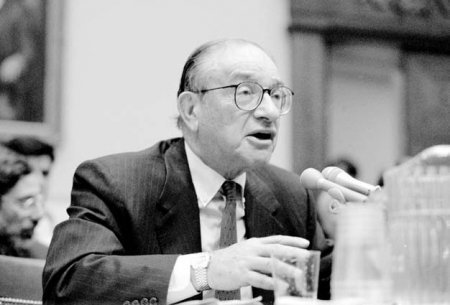Alan Greenspan
Identification: Thirteenth chair of the board of governors of the Federal Reserve Bank, 1987-2006
Born: March 6, 1926; New York, New York
Significance: The chair of the Federal Reserve is often described as the most powerful person in the United States after the president. In this role, Greenspan guided the nation’s monetary policy, helping maintain a stable business environment with relatively low inflation and unemployment.
A man of humble beginnings, Alan Greenspan seemed destined for a career in music rather than as the second longest serving chair of the Federal Reserve. In the fall of 1943, Greenspan was accepted at the prestigious Juilliard School. By early 1944, the chance to play with a jazz band took him on the road. However, that fall, realizing that he would never be a great musician, he left music to study economics at New York University.
In 1954, with a master’s degree in economics from New York University and experience gained through his work at the Conference Board, a nonprofit organization that analyzes business activity, Greenspan partnered with William Townsend to form Townsend-Greenspan, which provided economic analyses to businesses. In this role, Greenspan gained an in-depth knowledge of the economy.
During the early 1950’s, Greenspan was introduced to novelist and philosopher Ayn Rand and eventually became part of her inner circle. Rand, a proponent of free-market capitalism and distrustful of government involvement in the economy, had a profound influence on Greenspan. As part of her group, in 1966 Greenspan wrote an essay critical of the Federal Reserve, the central bank of the United States, and the role it played in creating inflation; he argued for a strict gold standard to tame the forces leading to inflation.
Ironically, just more than twenty years later, Greenspan was selected by President Ronald Reagan to lead the Federal Reserve. Greenspan had come to the attention of Republicans through one of his former bandmates, Leonard Garment. Garment, a law partner of Richard Nixon, brought Greenspan into Nixon’s 1968 presidential campaign. Later, Greenspan served as chair of the Council of Economic Advisors in the Ford Administration. By 1987, with his service in government and his experience analyzing the economy, Greenspan was seen as the leading candidate to replace Paul Volcker at the Federal Reserve.
Despite his previous criticisms of the agency, Greenspan was able to show how the Federal Reserve could provide a stable economic environment with low inflation, promoting economic growth and low unemployment. During his nearly nineteen-year tenure, Greenspan garnered much praise for the role he played in helping guide the economy through a number of potentially devastating crises, including the stock market crash in October, 1987, and the dot-com bubble in 2000. Under his leadership, the U.S. economy enjoyed modest growth with only two relatively minor recessions, in 1990-1991 and 2001. His words and actions were able to calm markets and maintain a relatively stable business environment.
Alan Greenspan. (AP/Wide World Photos)
During a Congressional hearing in October, 2008, however, Greenspan was harshly criticized for the role that his economic policies may have played in the financial crisis. He admitted being surprised by the depth of the crisis and stated that his belief in deregulation had been shaken. He said he had placed too much faith in the market’s powers for selfcorrection and failed to anticipate the mortgage lenders’ self-destructive actions. He still maintained that the changes occurring in the market during the crisis would function as a natural restraint on markets and his only suggestion for regulation was that any company selling mortgage-backed securities be required to hold a specified number of them.
Randall Hannum
Further Reading
Fleckenstein, William A., and Frederick Sheehan. Greenspan’s Bubbles: The Age of Ignorance at the Federal Reserve. New York: McGraw-Hill, 2008.
Greenspan, Alan. The Age of Turbulence: Adventures in a New World. New York: Penguin, 2007.
Woodward, Bob. Maestro: Greenspan’s Fed and the American Boom. New York: Simon & Schuster, 2000.
See also: Deregulation of financial institutions; Monetary policy, federal; Presidency, U.S.; Stock markets; Wall Street.


